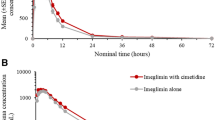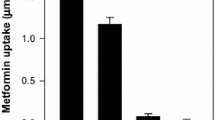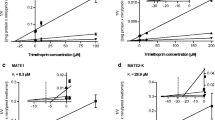Abstract
Background and Objective
Imatinib is primarily transported into the liver by organic cation transporter 1 (OCT1), organic anion transporting polypeptide 1B3 (OATP1B3), and novel organic cation transporter 2 (OCTN2), which is the first step in the metabolic and elimination of imatinib. Patients taking imatinib may concurrently take metformin, a substrate for OCT1. Drug-drug interactions (DDI) may occur between imatinib and metformin, affecting the clinical efficacy of imatinib. This experiment aimed to investigate the pharmacokinetic effects of metformin on imatinib and its active metabolism of N-desmethyl imatinib in rats.
Methods
Twenty healthy Sprague-Dawley rats were selected and randomly divided into control and experimental groups (10 rats per group). The control group was orally administered imatinib (30 mg/kg) for 14 days, and the experimental group was orally co-administered imatinib (30 mg/kg) and metformin (200 mg/kg) for 14 days. The plasma concentrations of imatinib and N-desmethyl imatinib in rats were determined by ultra-performance liquid chromatography-mass spectrometry. Pharmacokinetic parameters were calculated by DAS2.0 software.
Results
After single-dose co-administration of imatinib and metformin on day 1, the AUC0−24 (area under the plasma concentration-time curve) and Cmax (maximum concentration) of imatinib and the MRT (mean residence time) and Cmax of N-desmethyl imatinib in the experimental group were significantly decreased compared with the control group (P < 0.05). After multiple-dose co-administration of imatinib and metformin for 14 days, the AUC0−24 and Cmax of both imatinib and N-desmethyl imatinib were significantly decreased in the experimental group (P < 0.05).
Conclusion
With both single and multiple co-administration doses, metformin significantly changed the pharmacokinetic parameters of imatinib and N-desmethyl imatinib. The results suggest that care should be taken when metformin and imatinib are co-administered.


Similar content being viewed by others
Code Availability
Not applicable.
Data Availability
The datasets generated and analyzed during the current study are not publicly available but are available from the corresponding author.
References
Belda-Iniesta C, Pernia O, Simo R. Metformin: a new option in cancer treatment. Clin Transl Oncol. 2011;13(6):363–7.
Viollet B, Guigas B, Garcia NS, Leclerc J, Andreelli F. Cellular and molecular mechanisms of metformin: an overview. Clin Sci. 2012;122(6):253–70.
Zamek-Gliszczynski MJ, Bao JQ, Day JS, Higgins JW. Metformin sinusoidal efflux from the liver is consistent with negligible biliary excretion and absence of enterohepatic cycling. Drug Metab Dispos. 2013;41(11):1967–71.
Audia P, Feinfeld DA, Dubrow A, Winchester JF. Metformin-induced lactic acidosis and acute pancreatitis precipitated by diuretic, celecoxib, and candesartan-associated acute kidney dysfunction. Clin Toxicol. 2008;46(2):164–6.
Ding Y, Jia Y, Song Y, Lu C, Li Y, Chen M, et al. The effect of lansoprazole, an OCT inhibitor, on metformin pharmacokinetics in healthy subjects. Eur J Clin Pharmacol. 2014;70(2):141–6.
White DL, Saunders VA, Dang P, Engler J, Zannettino AC, Cambareri AC, et al. OCT-1-mediated influx is a key determinant of the intracellular uptake of imatinib but not nilotinib (AMN107): reduced OCT-1 activity is the cause of low in vitro sensitivity to imatinib. Blood. 2006;108(2):697–704.
Widmer N, Bardin C, Chatelut E, Paci A, Beijnen J, Levêque D, et al. Review of therapeutic drug monitoring of anticancer drugs part two—targeted therapies. Eur J Cancer. 2014;50(12):2020–36.
Maher HM, Alzoman NZ, Shehata SM. Ultra-performance LC–MS/MS study of the pharmacokinetic interaction of imatinib with selected vitamin preparations in rats. Bioanalysis. 2018;10(14):1099–113.
Alzoman NZ, Maher HM, Shehata SM, Abanmy NO. UPLC–MS/MS study of the effect of dandelion root extract on the plasma levels of the selected irreversible tyrosine kinase inhibitors dasatinib, imatinib and nilotinib in rats: potential risk of pharmacokinetic interactions. Biomed Chromatogr. 2019;33(12): e4674.
Hemminki K, Li X, Sundquist J, Sundquist K. Risk of cancer following hospitalization for type 2 diabetes. Oncologist. 2010;15(6):548–55.
Darweesh RS, El-Elimat T, Zayed A, Khamis TN, Sharie AHA. The effect of grape seed and green tea extracts on the pharmacokinetics of imatinib and its main metabolite, N-desmethyl imatinib, in rats. BMC Pharmacol Toxicol. 2020;21(1):77.
Novakovic ZM, Leinung MC, Grasso P. [D-Leu-4]-OB3, an orally bioavailable leptin-related synthetic peptide insulin sensitizer: a study comparing the efficacies of [D-Leu-4]-OB3 and metformin on energy balance and glycemic regulation in insulin-deficient male Swiss Webster mice. Peptides. 2013;43(1):167–73.
Chen X, Du L, Liu M. Development, validation, and application of an UPLC-MS/MS method for vancomycin, norvancomycin, methotrexate, paclitaxel, and imatinib analysis in human plasma. Ann Clin Biochem. 2022;59(4):253–63.
U.S. Department of Health and Human Services Food and Drug Administration Center for Drug Evaluation and Research (CDER) Center for Veterinary Medicine (CVM). Bioanalytical Method Validation Guidance for Industry. 2018. Available at https://www.fda.gov/media/70858/download. Accessed 8 October 2023.
Zhong DF, Li G, Liu CX. Guidance on bioanalysis: method validation and analysis of study samples (Draft). Drug Evaluat Res. 2011;34(6):409–15.
Karbownik A, Szkutnik-Fiedler D, Czyrski A, Kostewicz N, Kaczmarska P, Bekier M, et al. Pharmacokinetic Interaction between sorafenib and atorvastatin, and sorafenib and metformin in Rats. Pharmaceutics. 2020;12(7):600.
Minematsu T, Giacomini KM. Interactions of tyrosine kinase inhibitors with organic cation transporters and multidrug and toxic compound extrusion proteins. Mol Cancer Ther. 2011;10(3):531–9.
Skoglund K, Boiso Moreno S, Jönsson J-I, Vikingsson S, Carlsson B, Gréen H. Single-nucleotide polymorphisms of ABCG2 increase the efficacy of tyrosine kinase inhibitors in the K562 chronic myeloid leukemia cell line. Pharmacogenet Genom. 2014;24(1):52–61.
Eechoute K, Sparreboom A, Burger H, Franke RM, Schiavon G, Verweij J, et al. Drug transporters and imatinib treatment: implications for clinical practice. Clin Cancer Res. 2011;17(3):406–15.
Hu S, Franke RM, Filipski KK, Hu C, Orwick SJ, De Bruijn EA, et al. Interaction of imatinib with human organic ion carriers. Clin Cancer Res. 2008;14(10):3141–8.
Jensen JB, Sundelin EI, Jakobsen S, Gormsen LC, Munk OL, Frøkiær J, et al. [11C]-Labeled metformin distribution in the liver and small intestine using dynamic positron emission tomography in mice demonstrates tissue-specific transporter dependency. Diabetes. 2016;65(6):1724–30.
Han T, Proctor WR, Costales CL, Cai H, Everett RS, Thakker DR. Four cation-selective transporters contribute to apical uptake and accumulation of metformin in caco-2 cell monolayers. J Pharmacol Exp Ther. 2015;352(3):519–28.
Noritaka N, Shima H, Satoshi A, Ishimoto T, Sugiura T, Matsubara K, et al. Involvement of carnitine/organic cation transporter OCTN1/SLC22A4 in gastrointestinal absorption of metformin. J Pharm Sci. 2013;102(9):3407–17.
Umehara KI, Iwatsubo T, Noguchi K, Kamimura H. Functional involvement of organic cation transporter1 (OCT1/Oct1) in the hepatic uptake of organic cations in humans and rats. Xenobiotica. 2007;37(8):818–31.
Drozdzik M, Busch D, Lapczuk J, Müller J, Ostrowski M, Kurzawski M, et al. Protein abundance of clinically relevant drug transporters in the human liver and intestine: a comparative analysis in paired tissue specimens. Clin Pharmacol Ther. 2019;105(5):1204–12.
Muller J, Keiser M, Drozdzik M, Oswald S. Expression, regulation and function of intestinal drug transporters: an update. Biol Chem. 2017;398(2):175–92.
Jin S, Lee S, Jeon JH, Kim H, Choi MK, Song IS. Enhanced intestinal permeability and plasma concentration of metformin in rats by the repeated administration of red ginseng extract. Pharmaceutics. 2019;11(4):189.
Frank S, Binder L, Hafke A, Brandhorst G, Braulke F, Haase D, et al. Use of total and unbound imatinib and metabolite LC-MS/MS assay to understand individual responses in CML and GIST patients. Ther Drug Monit. 2011;33(5):632–43.
van Erp NP, Gelderblom H, Karlsson MO, Li J, Zhao M, Ouwerkerk J, et al. Influence of CYP3A4 inhibition on the steady-state pharmacokinetics of imatinib. Clin Cancer Res. 2007;13(24):7394–400.
Delbaldo C, Chatelut E, Ré M, Deroussent A, Séronie-Vivien S, Jambu A, et al. Pharmacokinetic-pharmacodynamic relationships of imatinib and its main metabolite in patients with advanced gastrointestinal stromal tumors. Clin Cancer Res. 2006;12(20):6073–8.
Wieczorek A, Uharek L. Management of chronic myeloid leukemia patients resistant to tyrosine kinase inhibitors treatment. Biomarker Insights. 2016;10(3):49–54.
Obbergh FV, Knoops L, Devos T, Beguin Y, Graux C, Benghiat F, et al. The clinical relevance of imatinib plasma trough concentrations in chronic myeloid leukemia. A Belgian study. Clin Biochem. 2017;50(7):452–4.
Acknowledgments
The authors acknowledge the support from the Fourth Hospital of Hebei Medical University (Shijiazhuang, China). The authors also acknowledge the support from People's Livelihood Science and Technology special projects of Key Research and Development Plan of the Science and Technology Department of Hebei Province (program number: 20377757D). The fund sponsor did not participate in the design and research of the article.
Author information
Authors and Affiliations
Contributions
Conceptualization: XC, LD, ML. Data curation: XC, NF, TG. Funding acquisition: XC. Investigation: XC, NF, TG. Writing–original draft: NF. Writing–review and editing: XC, NF.
Corresponding author
Ethics declarations
Conflict of Interest
All authors declared no conflicts of interest.
Ethical Statement
The study was approved by the Animal Ethics Committee of the Fourth Hospital of Hebei Medical University (grant no. 2023206). The study entitled was “Monitoring of imatinib plasma concentration for individualized treatment of gastrointestinal stromal tumors.”
Consent to Participate
Not applicable.
Consent for Publication
Not applicable.
Rights and permissions
Springer Nature or its licensor (e.g. a society or other partner) holds exclusive rights to this article under a publishing agreement with the author(s) or other rightsholder(s); author self-archiving of the accepted manuscript version of this article is solely governed by the terms of such publishing agreement and applicable law.
About this article
Cite this article
Fan, N., Du, L., Guo, T. et al. Pharmacokinetic Interaction Between Imatinib and Metformin in Rats. Eur J Drug Metab Pharmacokinet 49, 171–179 (2024). https://doi.org/10.1007/s13318-023-00869-x
Accepted:
Published:
Issue Date:
DOI: https://doi.org/10.1007/s13318-023-00869-x




